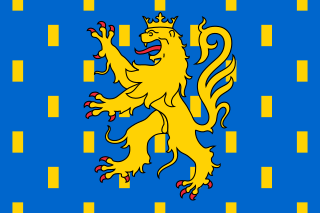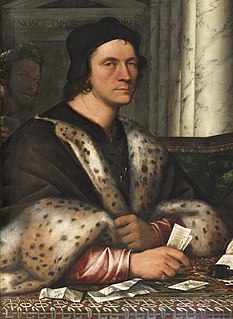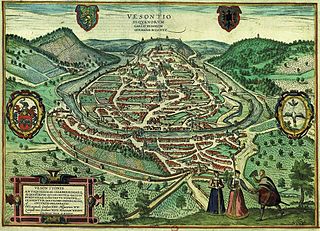
Franche-Comté is a cultural and historical region of eastern France. It is composed of the modern departments of Doubs, Jura, Haute-Saône and the Territoire de Belfort. In 2016, its population was 1,180,397.

Burgundy is a historical territory and former administrative region and province of east-central France. The province was once home to the Dukes of Burgundy from the early 11th until the late 15th century. The capital of Dijon was one of the great European centres of art and science, a place of tremendous wealth and power, and Western Monasticism. In early Modern Europe, Burgundy was a focal point of courtly culture that set the fashion for European royal houses and their court. The Duchy of Burgundy was a key in the transformation of the Middle Ages toward early modern Europe.

Besançon is the prefecture of the department of Doubs in the region of Bourgogne-Franche-Comté. The city is located in Eastern France, close to the Jura Mountains and the border with Switzerland.

Jura is a department in the Bourgogne-Franche-Comté region in Eastern France. Named after the Jura Mountains, its prefecture is Lons-le-Saunier. Its subprefectures are Dole and Saint-Claude. In 2019, Jura had a population of 259,199. Its INSEE code is 39. It has a short portion of the border of Switzerland.

Dole is a commune in the Jura department in the Bourgogne-Franche-Comté region, in eastern France, of which it is a subprefecture (sous-préfecture).

The Free County of Burgundy or Franche-Comté was a medieval county of the Holy Roman Empire, predecessor to the modern region of Franche-Comté. The name franc(he) comté derives from the title of its count, franc comte, in German Freigraf 'free count', denoting imperial immediacy. It should not be confused with the more westerly Duchy of Burgundy, a fiefdom of France since 843.

The Archdiocese of Besançon is a Latin Church ecclesiastical territory or archdiocese of the Catholic Church in France. It comprises the département of Doubs and the département of Haute-Saône.

Ferry Carondelet was a Habsburg diplomat, advisor to Margaret of Austria and abbot at Montbenoît. He was the younger brother of Jean Carondelet.
The Noble Order of Saint George of Rougemont was a baronial order of chivalry established around 1440 in the Free County of Burgundy. From the 15th through the late 18th centuries it enjoyed the protection of the Dukes of Burgundy and later the French kings. It was abolished in the wake of the French Revolution and became extinct after the death of the last knight in 1869.

The University of Franche-Comté (UFC) is a pluridisciplinary public French university located in Besançon, Franche-Comté, with decentralized campuses in Belfort, Montbéliard, Vesoul and Lons-le-Saunier.

Alexandre Marie Eleonor of Saint-Mauris, count of Montbarrey, then prince of Montbarrey and Prince of the Holy Roman Empire (1774), grandee of Spain of first class (1780), knight of the Holy Spirit, lieutenant general (1780).

The City of Besançon was a self-governing city surrounded by Franche-Comté.
The Free Imperial City of Besançon was a self-governing free imperial city that was part of the Holy Roman Empire. Its capital was Besançon.
Claude de La Baume (1534–1584) was a French Roman Catholic bishop and cardinal.

The Battle of Besançon was a sectarian conflict between the Protestants and Catholics in the French city of Besançon in the region of Franche-Comté. Prior to the battle, the Huguenots, accused of heresy, had been expelled from the city and fled to the County of Montbéliard and Switzerland; the outcasts formed an army and planned an attempt to retake Besançon and turn the city into a stronghold of the Protestant Reformation. By the time the armed Protestants had reached the city of Besançon however, their army had dwindled because of several mishaps. Nonetheless, the battle began and raged for several hours; the outcome was an overwhelming Catholic victory. The majority of the Protestant army managed to escape, but those who were captured were hanged as traitors. For over two centuries after the battle, Protestantism in Besançon was repressed.

Bourgogne-Franche-Comté is a region in Eastern France created by the 2014 territorial reform of French regions, from a merger of Burgundy and Franche-Comté. The new region came into existence on 1 January 2016, after the regional elections of December 2015, electing 100 members to the Regional Council of Bourgogne-Franche-Comté.
University Burgundy Franche-Comté is the association of universities and higher education institutions (ComUE) for institutions of higher education and research in the French region of Bourgogne-Franche-Comté. Its headquarters are in Besançon.

Radio BIP is a French local and associative FM broadcasting station, active in Besançon and Bourgogne-Franche-Comté. The acronym BIP stands for Bisontine, Indépendante et Populaire, meaning "Bisontine, independent and popular". After originally operating as a pirate radio station from 1977 to 1978, it was refounded in 1981 as a "free radio". In 2022 she still characterized by a total independence, the refusal of advertisement, and an important spot for politics and associations. Since 2015, her staff developps video and written channels with Média 25. She become a reference of social movement and underground culture, at the beginning of many cases during El Khomri law or Yellow vests.

The Besançon Commune was a short-lived revolutionary movement conceived and developed in 1871, aiming at the proclamation of a local autonomous power based on Lyon and Paris experiences. It originates from sociological upheavals which metamorphosed the city ·, and with the emergence of unions including a section of IWA in connection with the future Jura Federation · · · ·. The Franco-Prussian War, the fall of the Second Empire, and the advent of the Third Republic, precipitate events ·. While many notables testify to an insurrectional context and armed support from Switzerland is getting organized · ·, the correspondence left by James Guillaume and Mikhail Bakunin · attest to a planned release between the end of May and the beginning of June 1871. However, with the start of the Semaine sanglante on May 21 and the pursuit of an internal campaign until June 7, any attempt was seriously compromised. Despite the hope of a restart, the weeks and months following the idea of an insurrection is definitively abandoned reinforced by the extinction of the groups and activities called anarchists from 1875.

Éric Monnin is a French sports historian and sociologist, specializing in the International Olympic Movement. He holds a senior secondary school teaching degree in Physical Education and Sports. He graduated with a PhD in sociology and is a lecturer accredited to conduct research at the University of Franche-Comté. He is a member of the Culture, Sport, Health, Society (C3S) laboratory at the University of Franche-Comté.















